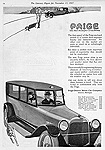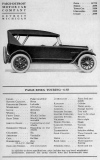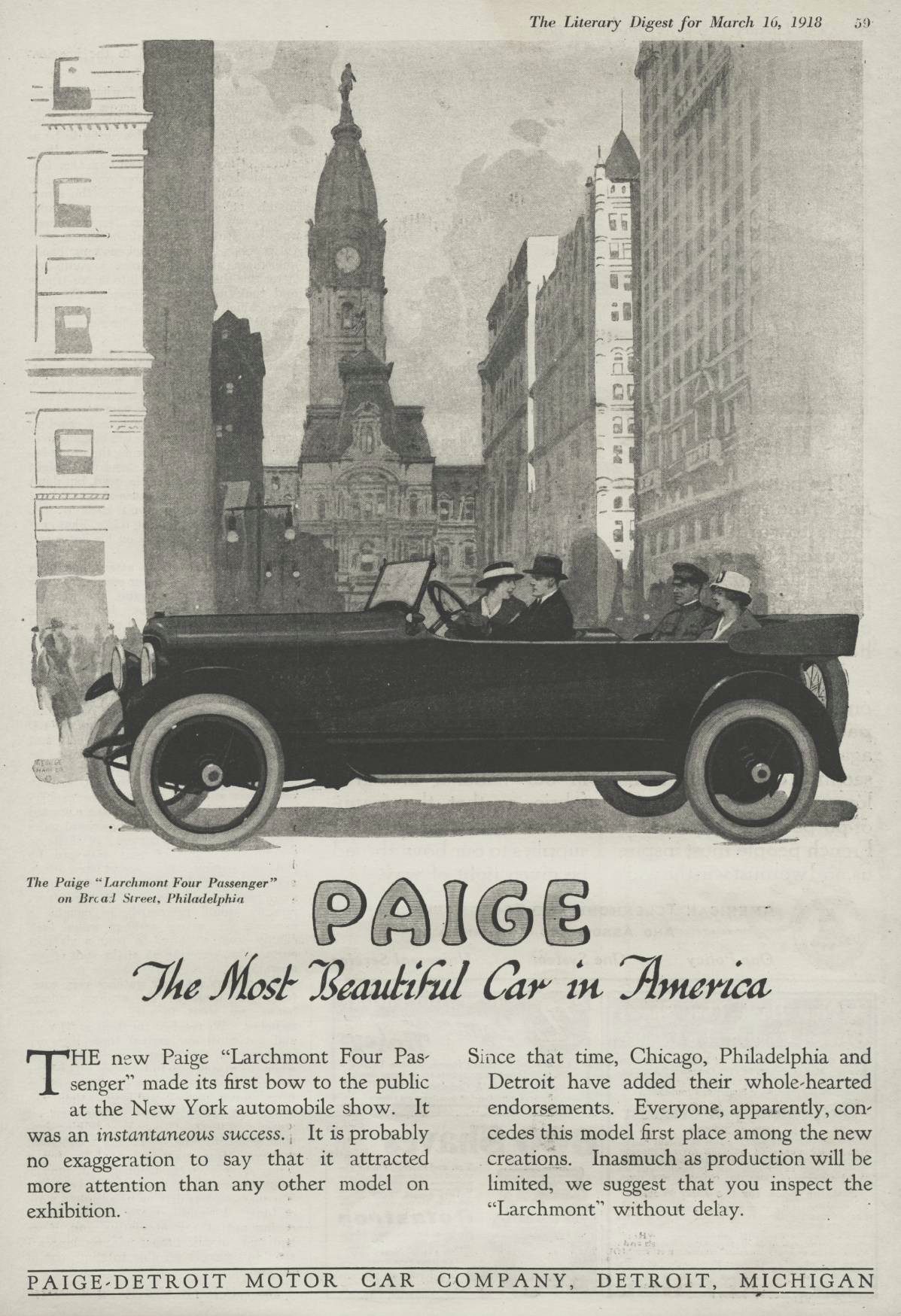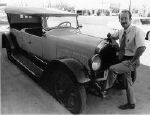| < 1917 | 1919 > |
1918 First Paige Truck
| Model: | "Six-39" | "Six-55" |
| Cylinders: | 6 | 6 |
| Horsepower SAE: | 23.44 | 29.4 |
| Wheelbase: | 117 | 127 |
The entry of the U.S. in April of 1917 into the European war affected profoundly the auto industry. Government contracts had priority. Civilian automobile production for 1918 models declined as the supply of material dried up. Auto makers had to use over-burdened railroads to deliver cars to dealers.
Nevertheless, before 1917 was over, Paige announced a 1918 lineup that featured only refinements in both series of six-cylinder models that otherwise stayed the same. One refinement was an engine valve refinement designed to reduce maintenance, described in a box below. Except for the Brooklands, which was carried forward from 1917, the larger series with a bigger motor was now labeled "Six-55," while the smaller remained "Six-39."
- "Six-51" Series
- Roadster, four-passenger, Brooklands, $1,795
- "Six-55" Series
- Coupé, four-passenger, $2,850
- Limousine, seven-passenger, $3,230
- Sedan, seven-passenger, $2,850
- Sport roadster, four-passenger, Larchmont, $1,950
- Touring car, seven-passenger, Essex, $1,775
- Town car, seven-passenger, $3,230
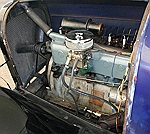 |
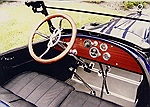 |
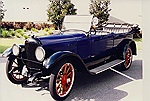 |
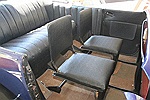 |
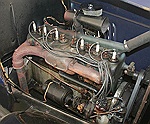 |
| 1918 Paige Six-55 Essex 7-passenger Touring Car (Walter Aiken collection) | ||||
The Essex seven-passenger touring, on the same 127 inch wheelbase as in 1917, made much of the rounded back of the body, "a feature that again marks the artistic genius of Paige designers." This apparently allowed a rear seat design that, according to the maker, allowed exceptional comfort unknown previously in touring cars of any size. This model came standard in royal blue with blue wheels with a white stripe.
The 1918 sales catalog included a drawing of the "Six-55" four-passenger coupe. This model and the center-door sedan could both be quickly converted into a open car by lowering the windows into the body and removing the side posts on both sides.
The Larchmont four-passenger sport model was shown with other 1918 models at the January automobile shows, but it was a new design that was not included in the fall announcement of Paige models. It was described in one ad as the ideal "Young Man's" Car, but one that appeared to have just as many friends among the older folks.
The March 2, 1918, Saturday Evening Post carried a Detroit Pressed Steel Co. ad featuring the Larchmont with its steel disc "Disteel" wheels, which were an option. Besides their aesthetic appeal they were more resilient and stronger than wooden spokes with no increase in weight. The manufacturer modestly claimed they were "as epoch-making as the introduction of the electrical starter".
The four closed models were available in a choice of three colors for the body below the molding: Brewster Green, hazel brown, or Paige Blue. Above the molding they were black. Three patterns of upholstery were available to harmonize with each of the colors. Head linings and carpets matched the choice of upholstery.
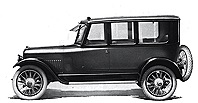 |
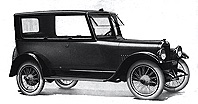 |
| Convertible Sedan (Enclosed) | Convertible Sedan (Open) |
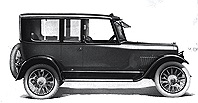 |
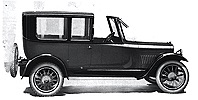 |
| Limousine | Town Car |
- "Six-39" Series
- Chummy Roadster, Glendale, $1,330
- Roadster, two-/three-passenger, Dartmoor, $1,330
- Sedan, five-passenger, $1,925
- Touring car, five-passenger, Linwood $1,330
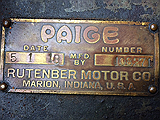 |
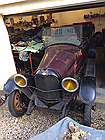 |
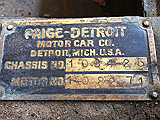 |
| 1918 Paige Linwood with matching motor and chassis plates (Nick Bell collection) | ||
 |
| 1918 Paige Six-39 Linwood 5-passenger Touring Car for sale in 2010 (EBay photo) |
The "Six-39" Series rode on a 117 inch wheelbase that was unchanged, like the larger series, from the previous year. The Dartmoor "Six-39" was a conventional two/three-passenger roadster, while the Glendale was designed for four passengers. The Glendale had only two doors, but front bucket seats enabled passengers to get to the rear seat. It was a well-proportioned car for the times. A buyer could order a Linwood "Six-39" five-passenger touring with a winter top installed at the factory for $198.50, or he could order the winter top to be shipped separately for $230 to put it on at his convenience.
All "Six-39" open models came with Brewster Green bodies, hoods, and radiators and with red wheels. The sedan came with a black upper body and a lower body of Richelieu Blue or Brewster Green. There were two patterns of upholstery for the sedan to harmonize with either color.
The gas tank in the larger series was now at the rear of the car. It held 23 gallons, and a Stewart vacuum system moved the gas to the motor. In the smaller series the gas tank was still under the cowl. It held 14 gallons, and the carburetor was fed by gravity. Both had a triple plate dry clutch.
Details of the New Paige Valve Truing Device
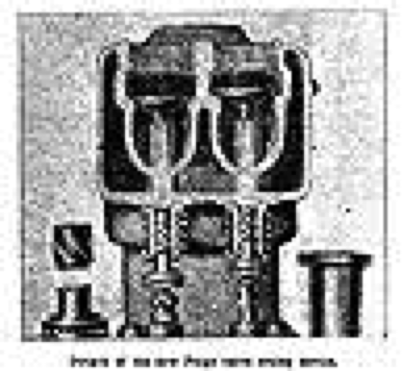 |
The Paige folk have developed one of the big novelties of the show in the shape of a specially designed valve system whereby the valve is caused to rotate on its seat with each operation so that both the valve and its seat are kept in prime condition and the necessity for frequent valve grinding is done away with.
The operation of the Paige valve-rotating device is made perfectly plain by the accompanying drawing. The valve rotator consists of four main parts; a threaded boss slipped over the valve stem near the bottom; a hollow sleeve rigidly attached to the valve pocket casting in place of the more orthodox valve stem guide and which is threaded internally to engage the boss; a ball thrust bearing, the lowermost section of which is attached to the valve stem, while the uppermost section is provided with a clutch arrangement with saw teeth intended to engage with similar teeth on the lower edge of the boss, and a helical spring interposed between the sleeve and the upper section of the thrust bearing and which takes the place of the usual valve spring.
In operation, the upward movement of the valve stem causes the teeth of the clutch to engage so that the rotational movement of the boss is communicated the valve stem, the direction of rotation being against the resistance of the coil spring. As the valve stem drops, the spring brings the thrust bearing back to its original position, disengaging the teeth so that there is no rotation of the valve on the return stroke. The action causes the valve stem to make a complete turn on its seat, every three strokes of the valve bringing a different portion of the valve head into the path of the flaming gases on each stroke, thereby reducing pitting and tendency to warp and making valve grinding a less frequent necessity.
The American Chauffeur Magazine, January, 1918
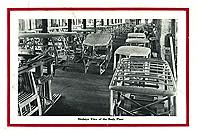 |
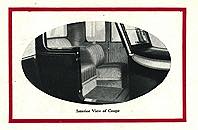 |
| Body Plant | Coupe Interior |
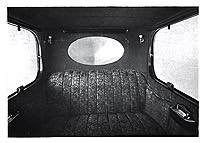 |
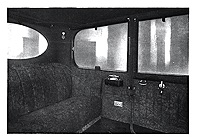 |
| Tonneau Back | Tonneau Side |
Sale of Paige Denied
Detroit, July 1 - The rumor that the General Motors Co. is about to purchase the Paige-Detroit Motor Car Co. is unfounded, according to H. M. Jewett, president of the Paige company. The Paige company has been approached several times in the past by the General Motors Co. with offers, and the recent visit to the east of Mr. Jewett, who sought an interview with W. C. Durant of General Motors, caused an over-zealous newspaper correspondent to write a story to the effect that Mr. Jewett's visit was prompted by a desire to go through with the deal. As a matter of fact, the conference between the two men dealt only with the steel situation.
Motor Age Magazine, July 4, 1918
Paige increased prices more than once during the model year because of the scarcity of material. Motor Age magazine printed the following announcement of the latest change in its issue of August 8, 1918:
| Model | Old | New | Advance |
|---|---|---|---|
| Six-39 | $1,395 | $1,515 | $120 |
| Essex six-55 | 1,830 | 1,985 | 155 |
| Larchmont six-55 | 1,950 | 2,090 | 140 |
In contrast to earlier print ads that may have shown a family in its stylish Paige at the seaside, by summer a Paige-Detroit ad showed smiling military officers in a Paige touring car with barracks in the distant background. In the ad Paige-Detroit encouraged the business executive to buy a Paige auto as his contribution to the war effort, because it would free him from slowly moving, congested public transport. In a leap of advertising logic, thus would the businessman's auto contribute to the speed of developing the country's industrial strength, which was necessary to exert its full military strength on the battlefields of Europe. This was not the time, the company asserted, for "parsimonious hoarding that leads to industrial stagnation and inertia".
Paige-built Nash “Quad” Truck Chassis
The Quad was a four-wheel drive truck (15 miles per hour recommended speed) first built by the Thomas B. Jeffrey Co., Kenosha, Wisconsin, from 1913, and after 1916 by Nash Motors. It had optional four-wheel steering, which provided improved performance on the often muddy, unpaved roads of the day by enabling the rear wheels to follow the tracks created by the front wheels.
In the spring of 1918 Nash agreed to supply the U.S. Army with nearly 3,000 Quad chassis and allowed the U.S. government to subcontract additional Quad production to other manufacturers. Shortly thereafter the government issued contracts for 2,000 Nash Quad trucks to Paige and to three other firms:
- Paige-Detroit Motor Car Co., Detroit
- Hudson Motor Car Co., Detroit
- National Motor and Vehicle Corp., New York
- Premier Motor Corp., Indianapolis
By war's end in November, 1918, Hudson had delivered about 200. The numbers completed by Paige and by the other companies are unknown.
 |
 |
 |
 |
| My project (Rich Dunn photo) | Dash data plate (Rich Dunn photo) | Wood seat box plate (Rich Dunn photo) | Restored Paige-built Quad (Rich Dunn photo) |
Paige Truck
In November Paige launched a truck line that had been announced earlier in the spring of 1918. The company planned to market a complete line of trucks, ranging from 1-ton to 5-ton capacities. A limited number of the new trucks were to be distributed initially. As war conditions made it possible, production was to be increased and other models were to be added.
The first model, the 2-ton for $2,950, was powered by a four-cylinder Continental engine, having a bore and stroke of 4-1/8 by 5-1/4 inches, which developed 27 horsepower SAE. It was not fitted with a starting and lighting system. Other features included:
- Stromberg carburetor with gravity fuel feed
- Bosch ignition
- Pierce governor
- Selective sliding gear and multiple dry-disk clutch
- Total gear reduction in low: 34 to 1; in high: 8-1/2 to 1
- Cooling by centrifugal pump and spiral, finned-tube radiator
- Pressed steel frame
- 150-inch wheelbase
- Solid tires: 36 by 4 in front and 36 by 7 in the rear
- Wooden wheels with square spokes
- 3-1/2 by 1/4 brake banding
- Timken worm-type rear axle with exceptionally sturdy, drop-forged radius rods
- Timken bearings in the front wheel , gearset and rear axle
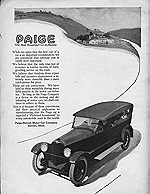 |
 |
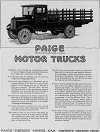 |
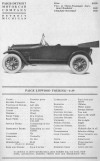 |
| 1918 Essex. The Literary Digest, June 15, 1918 | 1918 Larchmont. Popular Science, May, 1918 | First Paige truck. Saturday Evening Post, Dec. 21, 1918 | 1918 Six-39 Linwood. N.A.C.C. Annual Hand Book |
Elsewhere:
- Sunday driving is banned to conserve fuel because of U.S. involvement in the war in Europe.
| < 1917 | 1919 > |
